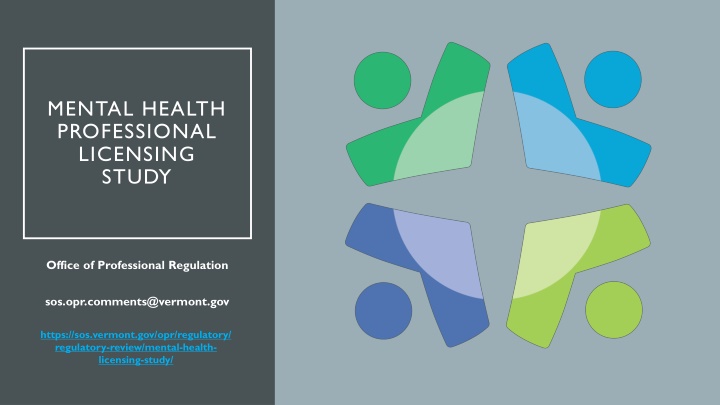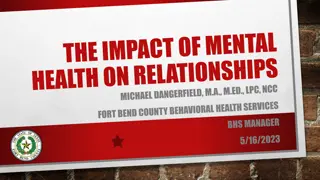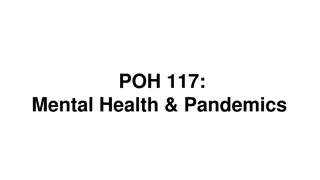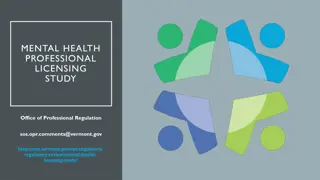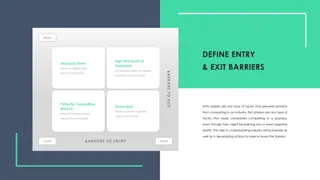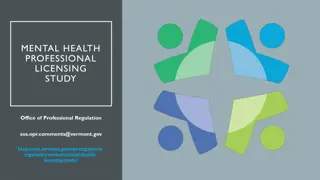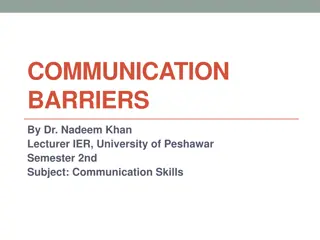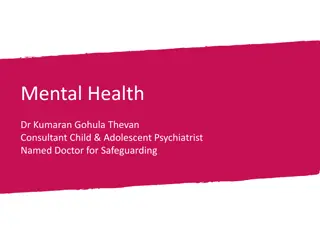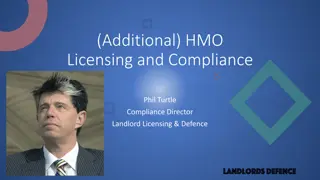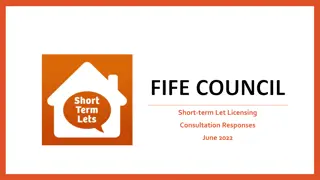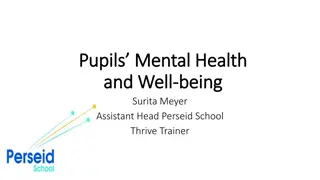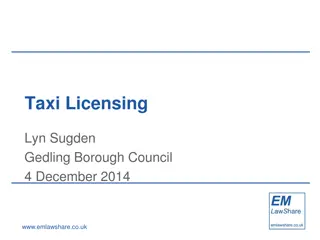Addressing Barriers to Mental Health Professional Licensing
This information highlights key issues and challenges related to mental health professional licensing, including barriers to entry, subgroup questions for improvement, and the need for equity, accessibility, and coordination in licensing processes. It focuses on areas such as examinations, lack of guidance, pathways to licensure, supervision requirements, continuing education, and clarity in regulatory processes.
Download Presentation

Please find below an Image/Link to download the presentation.
The content on the website is provided AS IS for your information and personal use only. It may not be sold, licensed, or shared on other websites without obtaining consent from the author.If you encounter any issues during the download, it is possible that the publisher has removed the file from their server.
You are allowed to download the files provided on this website for personal or commercial use, subject to the condition that they are used lawfully. All files are the property of their respective owners.
The content on the website is provided AS IS for your information and personal use only. It may not be sold, licensed, or shared on other websites without obtaining consent from the author.
E N D
Presentation Transcript
MENTAL HEALTH PROFESSIONAL LICENSING STUDY Office of Professional Regulation sos.opr.comments@vermont.gov https://sos.vermont.gov/opr/regulatory/ regulatory-review/mental-health- licensing-study/
AGENDA Welcome Present and Discuss Subgroup Meeting Work Next Steps Identifying Resources, Research, and Learning Opportunities Continued Steps New and Refined Issues and Questions Throughout Update: New email communications coming soon
We're here! 11/20/23 Questions and Goals and Scope Research, Resources, and Learning Report Recommendations
BARRIERS TO ENTRY Examinations (need for accommodations and alternatives) Lack of guidance on how to pursue licensure (e.g., website problems, inaccessible language and resources) Pathways to licensure (need to simplify and expand, particularly for those out-of-state) Specificity of the current requirements (e.g.,1:30 ratio of supervision to supervised practice) "Threshold" qualifications and post-degree supplementation Continuing education requirements across all professions (equity,cost, time, need, consistency, etc.) Confusing qualifications (e.g., "psychotherapy" and social work; direct vs. indirect supervision) Multiple boards and regulatory requirements for professions with similar but different practices Lack of qualified supervisors Cost and payment structure for supervision Disconnect between licensing and reimbursement (time after licensure to credentialing, roster timeline,etc.) Licensing requirements inconsistent with those of surrounding states Clarity of process for obtaining VT license based on license in another state Access and barriers to obtaining required education (financial, time, location, etc.) Clarity of process for obtaining a telehealth license or a compact license No license for disciplines (e.g., art therapy, music therapy, school counseling) No regulation of supervisors The Roster, its role, timing requirements, and impact of both (e.g., public protection, ability to obtain license,counting of supervision hours,reciprocity) No way to confirm supervision is compliant until finished
BARRIERS SUBGROUP QUESTIONS How can we be more equitable in mental health professional licensing? Continuing education, access to education, cost and access to relevant supervision How can the laws be improved for professionals-in-training? The Roster Affordability, access, non-monetary costs Exams, supervision hours, coursework Guidance, clarity How do we improve the post-degree supervised practice and supervision requirements? Address equity, cost, oversight, etc. Maintain availability How do we work with partners to ensure coordination with other practice needs (e.g., reimbursement)? How do we address barriers to licensure for other disciplines and out-of-state professionals?
BARRIERS TO ENTRY Additional Resources
SUPERVISION Barriers to supervision Workforce development Accommodations Cross-profession supervision requirements Supervisor qualifications Supervision contracts (accountability and transparency) Private practice v. agency settings Supervision hourly rules criteria Direct v. indirect service criteria Definition of supervised practice hours (what counts?) Documentation of supervised hours (e.g., supervisor reports) Communication with applicant during supervised practice Clarity of requirements and guidance Ethical requirements (e.g.,payment structures, multiple relationships) Number of supervisees Regulating the supervisor Consistency with surrounding states
SUPERVISION HOW CAN WE BALANCE ACCESS TO SUPERVISION WITH DIFFERENT INTERESTS OF SUPERVISORS AND SUPERVISEES? HOW CAN REGULATIONS MAKE SUPERVISION MORE ACCESSIBLE? HOW CAN REGULATIONS REDUCE BARRIERS TO SUPERVISION? Oversight of supervisor-supervisee relationship Oversight of supervised practice Should providing supervision require training or additional CE? How can OPR streamline supervision requirements across all mental health professions? Should providing supervision be a revocable privilege, e.g., in the event of misconduct? What does quality supervision mean? How can additional oversight improve supervision? Should OPR standardize supervision contracts? How can the supervised practice regulations be revised to improve access while still protecting the public? What is considered fair and equitable in supervision arrangements/contract terms? What are the risks we are concerned about with poor quality supervision? Should OPR actively track supervision hours/relationships? What are the concerns around supervision business models? Is it possible to create more flexibility in supervision pathways to licensure? Are there employment complications for professionals-in-training as independent contractors?
SUPERVISION Additional Resources
STREAMLINING LICENSE REGULATIONS STREAMLINING LICENSE REGULATIONS Education requirements that reflect current access and cost realities Supervision requirements and regulation Integration of out-of- state requirements into VT licensing CE requirements; multiple license types;equity;barriers Balancing administration and clarity of licensing requirements with need for multiple pathways to licensure Roster role, public protection,impact Coordination with other entities that impact practice (e.g.,insurers) Inclusion of discipline licenses (e.g., art therapy, music therapy,school counseling) Telehealth and compact integration Applicant communication and awareness of application status (and problems)
STREAMLINING SUBGROUP QUESTIONS How can we balance the need for multiple pathways to licensure with the needs for public protection, clarity, and the ability to administer the rules? How can we ensure the requirements for licensure protect the public while minimizing the barriers to obtaining licensure (e.g., cost of education,access to supervision, etc.)? How can OPR better coordinate with other entities that impact professional practice? How can regulations incorporate mental health disciplines (e.g.,art and music therapy, school counselors, forensic psychologist evaluations) How can we streamline post-licensure requirements to ensure equity and access? How can use of the roster better serve professionals-in-training as well as public protection? How can we improve out-of-state endorsement pathways for professionals/trainees? How would a single mental health board function for multiple mental health professions?
STREAMLINING Additional Resources: 3rd-Party certification bodies Other states
NEXT STEPS: RESEARCH & RESOURCES What resources would be helpful to answer these subgroup questions? What stakeholder groups should be considered and how can we include their participation? What can Vermont learn from other states regulatory programs? What other research would you like OPR to conduct? What other research and resources does this group have available?
NEXT MEETING DATES Full Group Meeting Dec. 18 Subcommittees: 2-4pm Barriers to Entry Nov. 28 Supervision Dec. 5 Streamlining and Barriers Dec. 12 Sos.opr.comments@vermont.gov
